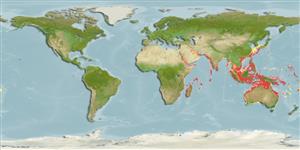>
Ovalentaria/misc (Various families in series Ovalentaria) >
Pomacentridae (Damselfishes) > Pomacentrinae
Etymology: Pristotis: Greek, pristis = saw + Greek, ous, otis = ear (Ref. 45335).
More on author: Günther.
Environment: milieu / climate zone / depth range / distribution range
Ecologia
marinhas associadas(os) a recifes; não migratória; intervalo de profundidade 2 - 80 m (Ref. 9710). Tropical
Indo-West Pacific: Red Sea and Persian Gulf to the Ryukyu Islands, Taiwan, Indonesia, New Guinea, and northern Australia.
Tamanho / Peso / Idade
Maturity: Lm ? range ? - ? cm
Max length : 14.0 cm TL macho/indeterminado; (Ref. 9710)
Descrição breve
Chaves de identificação | Morfologia | Morfometria
Espinhos dorsais (total) : 13; Raios dorsais moles (total) : 12 - 13; Espinhos anais: 2; Raios anais moles: 12 - 14.
Usually identified as P. jerdoni (Day, 1873), a junior synonym (Ref. 48636). Adults are found mainly along continental margins rather than truly oceanic areas. Inhabits flat sandy or rubble bottoms around patch reefs of lagoons and trawling grounds (Ref. 7247). Adults often seen in small groups out in the open on sandy substrate, swimming well-above the bottom and unlike other damselfishes rely on speed to get away from predators rather than diving into the shelter or reefs or burrow. Juveniles often shallow estuaries, but adults mainly in deeper water offshore at depths of 20+ m and have been reported to 80 m depth (Ref. 48636). Oviparous, distinct pairing during breeding (Ref. 205). Eggs are demersal and adhere to the substrate (Ref. 205). Males guard and aerate the eggs (Ref. 205). Diurnal species (Ref. 54980; 113699).
Life cycle and mating behavior
Maturidade | Reprodução | Desova | Ovos | Fecundidade | Larvas
Oviparous, distinct pairing during breeding (Ref. 205). Eggs are demersal and adhere to the substrate (Ref. 205). Males guard and aerate the eggs (Ref. 205).
Randall, J.E., 1995. Coastal fishes of Oman. University of Hawaii Press, Honolulu, Hawaii. 439 p. (Ref. 11441)
Categoria na Lista Vermelha da IUCN (Ref. 130435: Version 2024-1)
Ameaça para o homem
Harmless
Utilização humana
Pescarias: pescarias de subsistência; Aquário: Espécies comerciais
Ferramentas
Relatórios especiais
Descarregue XML
Fontes da internet
Estimates based on models
Preferred temperature (Ref.
123201): 24.3 - 29, mean 27.8 °C (based on 1240 cells).
Phylogenetic diversity index (Ref.
82804): PD
50 = 0.7500 [Uniqueness, from 0.5 = low to 2.0 = high].
Bayesian length-weight: a=0.01549 (0.00794 - 0.03021), b=2.98 (2.81 - 3.15), in cm total length, based on LWR estimates for this species & (Sub)family-body (Ref.
93245).
Nível Trófico (Ref.
69278): 3.5 ±0.51 se; based on food items.
Generation time: 1.4 ( na - na) years. Estimated as median ln(3)/K based on 1
growth studies.
Resiliência (Ref.
120179): Elevada, tempo mínimo de duplicação da população menor que 15 meses (K=0.8).
Fishing Vulnerability (Ref.
59153): Low vulnerability (17 of 100).
Nutrients (Ref.
124155): Calcium = 96.2 [61.6, 162.0] mg/100g; Iron = 0.898 [0.580, 1.375] mg/100g; Protein = 18.8 [17.8, 19.8] %; Omega3 = 0.173 [0.110, 0.267] g/100g; Selenium = 29.6 [17.4, 52.9] μg/100g; VitaminA = 163 [64, 410] μg/100g; Zinc = 1.49 [1.04, 2.02] mg/100g (wet weight);
